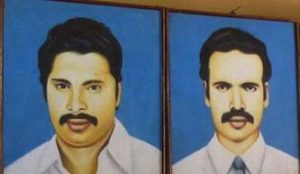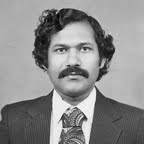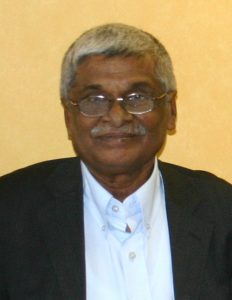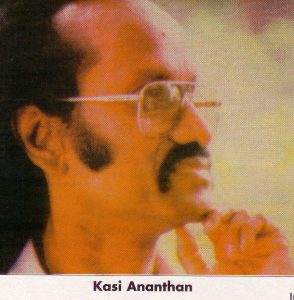by T. Sabaratnam, August 15, 2003
Volume 1, Chapter 5
Original index of series
Original Volume 1, Chapter 6
Pirapaharan entered the freedom struggle in the role of a leader of an armed group when he was 17 years old. He led a bomb attack on 17 September 1972 at the carnival held at Duraiappah Stadium, Jaffna. He was then the head of a hand picked, active and dedicated group of young men: Chetti, Sivarajah, Ramesh, Inbam, Kannady, Saravanan (alias Patkunarajah), Kalapathy and Kirupaharan–all elder to him.
He named that group Tamil New Tigers (TNT). He wanted TNT to be the deadly exploder of Sinhala extremism and Tamil conservatism.

Kuttimani and Thangathurai
Pirapaharan, who joined the Thangathurai-Kuttimani group in 1969, when he was 15, had gradually built himself into a leader through his energy, bravery, organizational skill and dedication. Chelliah Thanabalasingham (alias Chetti), Periya Sothi, his cousin, and Chelliah Pathmanathan (alias Kannadi) went with him to fling the homemade hand-bombs at the Duraiappah Stadium.
The exact date of the formation of the TNT is difficult to fix because it was the outcome of a gradual evolution and former militants whom I met say Duraiappah Stadium attack was TNT’s first act of violence. Others consider the murder of Alfred Duraiappah on 27 July 1975 as the first act of violence by the TNT. They base their decision on LTTE Central Committee’s claim of responsibility issued on 25 April 1978. Uma Maheswaran who drafted that letter might have decided to start with Duraiappah murder because that was a major event. The interesting story connected to that letter would be told later.
Duraiappah Stadium attack led to an intensification of the police hunt of the members of the Tamil Students Union (TSU) but it took months before police learnt about Pirapaharan. That was because Pirapaharan, during that time, was very busy organizing the TNT. Most of the TSU leaders too were not aware of the TNT. Pirapaharan organized his group in strict secrecy. Police suspected Thangathurai- Kuttimani group for the Duraiappah Stadium attack as their focus then was on that group.

Duraiappah Stadium
Pirapaharan and his associates spent many hours shaping the TNT. Influenced by the teachings of Subash Chandra Bose, Swami Vivekananda and the practice of his father Velupillai he drew a strict code of discipline for his group. They should abstain from alcohol and tobacco and dedicate their life to the cause of the Tamil race. They decided to call themselves Tigers because Tiger was the emblem of the Cholas who established a mighty empire in south India, Sri Lanka and the far east at the beginning of the second millennium. Pirapaharan adopted the Tiger flag and the crest for the TNT.
Pirapaharan was, at that time, living with his parents in Valvettithurai. He slipped from home for short periods to establish his secret outfit. His parents were completely unaware of his clandestine activities. The opportunity for the parents to know of his revolutionary activities came knocking at the door on its own in March 1973 when the police launched a crackdown on the newly formed Tamil Elaignar Peravai (Tamil Youth Forum).
The TUF decision to attend the National State Assembly brought the political leaders and the youth into direct confrontation. “Explain to us the logic of your actions,” asked a leaflet issued by the TSU. “You told us that the new constitution is a Charter of Slavery and now your parliamentarians have taken oath as members of the National State Assembly swearing allegiance to the same constitution. Are you not lending legitimacy to the constitution that had made us slaves? Are you not a party to making Tamils slaves of the Sinhalese?”
The only answer Tamil parliamentarians could give was that they were attending the meetings of the National State Assembly to agitate against the constitution and to watch the interests of the Tamil people. Youth leaders said they were unable to comprehend that argument and the leaders shot back: You are unable to comprehend because you are not mature. Youths accused the leaders of trying to enjoy the comforts and benefits of membership in the National State Assembly.
To take off the youth pressure and to combat government propaganda TUF leader Thanthai Chelva launched on September 2, Mahatma Gandhi’s birthday, satyagraha and announced that that was the commencement of the non-violent struggle to win back Tamil rights. To pacify the youth they commenced the satyagraha with the hoisting the Nadhi flag, the flag of the Jaffna kings and the Rising Sun flag to denote the rise of a new nation and Amithalingam’s wife Mangayarkarasi sang the Thamil Thai Valthu.
Thanthai Chelva also announced that he would resign his seat in parliament the next day after explaining to the National State Assembly the reason. He said his resignation would be sufficient to convey to the world the message that the Tamil people had rejected the new constitution. Next day, October 3, he announced his resignation in the National State Assembly and challenged the government to hold a by-election to test Tamil opinion. The government did not take that challenge. It postponed the by-election repeatedly.
Amirthalingam, realizing that the TSU had gone out of his control and police arrest of its leaders had almost crippled it, used the pretext of the formation of the Tamil United Front to found a new youth organization in January 1973, the Tamil Elaingyar Peravai (Tamil Youth Forum- TYF). It had a membership of about 40 youths; many of whom subsequently became leaders of the militant movement. It brought together active youths of different political persuasions. Although not a TUF affiliate, Amirthalingam saw to it that it was controlled by a group of TUF loyalists headed by Mavai Senathirajah and others close to him.
TYF did whatever Amirthalingam wished it to do, which left-leaning members resented. Pakiyanathan Rajaratnam, who played a central role in the activities of the TYF said: “we did whatever Amirthalingam asked us to do.”
TYF came under police surveillance soon after its formation on January 14, the Thai Pongal day. Two of its activists, G. Gnanasekaram and Aseervatham Thasan, were arrested the next day, on January 15. Another, Ponnuthurai Satiyaseelan, who founded the TSU, was arrested on February 20. Then followed the police crack down on the TYF. It was rumoured at that time that Satyaseelan had spilled the beans when given the “proper police treatment”. The belief prevails among the militant groups even now. They say Satyaseelan had given the police the list of members of the TYF and their activities.
The police swooped on all the important members of the TYF in March. Somasundaram Senathirajah, known as Mavai, Anandapoopathy Balavadivetkaran, and Sivaramalingam Chandrakumar were arrested on March 9. K. Sundarampellai Sabaratnam was arrested on March 10 and P. V. Tissaverasingam March 16. Police continued its arrests as evidence pointed to others. S. Appathurai Nithianandan was taken into custody in May and Sivaramalingam Suriakumar in July. There were others whose names I am sorry to have forgotten.
Underground Life
Thangathurai, Kuttimani. Periya Sothi and some others went into hiding. Pirapaharan was at his home in mid March when a police squad knocked at the front door at 3 a.m. Pirapaharan knew the Police had come for him. He slipped through the back door.
Pirapaharan’s mother Parvathi opened the door and was startled to see the posse of policemen. They told her and her two daughters who stood behind their mother, they had come to take Pirapaharan into custody. Without waiting for an answer, police constables searched the house and returned empty handed. The inspector bragged to the two teenage girls that their criminal brother had escaped but they would get him soon.
Sri Lankan police never arrested Pirapaharan. He was always two steps ahead of them.
Pirapaharan, his close associates said, went underground after this police search. In an interview to Ram, Pirapaharan confirmed this. He said;
I went underground around 1973…
He added that leading an underground life was very difficult;
… and you know leading an underground life is a very difficult proposition. I have led an underground life for a long time… it was a very difficult period for us, with the army on the rampage… to escape their net was very difficult.
Pirapaharan teamed up again with Thangathurai and Kuttimani and went hiding. Relatives say Velupillai went to their hideout and begged his son to return home but he declined. He told his father,
I will never be of any use to you or to other members of the family. If I return there will be trouble for you and our family. Let there be no trouble for you because of me. Please allow me to go my own way. In future never expect anything from me.
Police did not leave him in peace. Their net swiftly closed around him. So he sailed to Tamil Nadu with Thangathurai, Kuttimani and Periya Sothi in one of Kuttimani’s boats. They landed in Vetharaniyam, the popular landing point for Sri Lankan Tamils. He remained there with Periya Sothi as he wanted to go to Chennai, then Madras, to set up a cell there and build contacts with Tamil Nadu politicians. Thangathurai and Kuttimani went to Salem. Pirapaharan and Periya Sothi had a hard time there, living on cheap curd rice and temple prasatham. There were days they slept with empty stomachs. In Chennai, they sought Janardhanan’s help to hire a small house in Kodampakkam. Janardhanan struck an instant friendship with young Pirapaharan. Janardhanan explained the reason thus;
He was very young and extremely shy. He had a pair of piercing eyes. He was itching for action and yearning for knowledge. I was quite surprised at his searching questions. He had a deep understanding of Tamil Nadu politics. I took him often for dinners. I enjoyed the discussion and he relished the meal.
Pirapaharan was short of cash and lived frugally. Periya Sothi cooked their meals, mostly rice and one or two vegetables. Pirapaharan, a lover of non-vegetarian food, cooked chicken every Saturday. Pirapaharan, active by nature, was tired of this lethargic life. He wanted to return to Jaffna, the scene of action. When he learnt in 1974, that his former colleague Chetti, had escaped from Anuradhapura prison and had taken up residence at Mylapore, another part of Chennai, Pirapaharan met him. Chetti and three others- Kannadi, Appaiah and Sivarajah escaped from Anuradhapura prison in 1973. Pirapaharan and Chetti decided to return to Jaffna. Periya Sothi objected. He warned Pirapaharan not to keep company with Chetti. He told his cousin that Chetti had turned unreliable and had become a common criminal. Pirapaharan would not listen. He told him that Chetti was a man of action. Pirapaharan told Periya Sothi:
You are content spending your life, cooking, eating and sleeping. I do not want to waste my life like that. I want action. I must do whatever I can while I am young and able. Chetti, like me, is a man of action.
Periya Sothi was unhappy about Pirapaharan’s decision to rejoin Chetti. He tried to block their returning to Jaffna. He first spoke to Thangathurai and Kuttimani who tried to dissuade Pirapaharan. He then got Janardhanan to speak to him. Janardhanan recalls talking to Pirapaharan. He said he had no answer to Pirapaharan’s reply;
I am aware of the criminal side of Chetti’s life. As for me, I will never, never lose my identity.
Thangathurai and Kuttimani were annoyed that Pirapaharan, much younger to them, had turned down their advice and had teamed up with Chetti, an outsider from Kalviyankadu, a suburb of Jaffna city. Janardhanan said he understood the young man’s feelings and his desire for action.
When Pirapaharan landed in Jaffna in mid- 1974 Jaffna people were angry with Sirimavo Bandaranaike’s government and were convinced that the only way available for them to preserve their dignity was through the establishment of a separate state. This was partly due to the antics of Posts Minister Kumarasuriyar and the Mutpokku Eluthlar sangam controlled by the Soviet embassy staff and partly Sirimavo Bandaranaike’s Sinhala chauvinism.
In 1973 and 1974, Sirimavo Bandaranaike made two attempts to soothe the feelings of the Tamils. She made those attempts due to political necessity. The UNP headed by J. R. Jayewardene was leading a satyagraha movement against the government’s effort to take over the Lake House group of newspapers, the largest publishing house in Sri Lanka. Thondaman, a president of the TUF, supported the satyagraha. The government was concerned and its strategists decided to prevent the TUF leaning towards the UNP.
Leaders Put Back on Track
On 23 March 1973, the government enacted the Language of the Courts Act which provided for the use of the Tamil language in courts in the northern and eastern provinces. Tamils wanted it made part of the constitution which the government declined to do.
The Action Committee of the TUF met on 17 May 1973 at the Federal Party headquartes in Jaffna when members of the TYF staged a demonstration opposite the headquarters and demanded they take action to set up a separate state. At the meeting Eelath Thamilar Oottumai Munnani leader Suntharalingam proposed that the TUF initiate the preliminary steps for the establishment of the state of Tamil Eelam. He suggested that all Tamil MPs constitute themselves into a Constituent Assembly and elect a committee to draw up the draft constitution. The Federal Party and the Tamil Congress were not prepared to go that far and were agreeable to the election of a committee to report on the future course of action.
The youths were dissatisfied by the refusal of the Action Committee to set up a committee to draw up the constitution and were incensed by its decision to work for the “establishment of self-rule of the Eelam Tamil nation in their traditional homeland.” They read into the phrase “self –rule” an attempt to return to the concept of federalism. They accused the Tamil leadership of trying to stick to their parliamentary seats, that their main concern was their powers and privileges and were immune to the aspirations and sentiments of the people.

Uma Maheswaran
TYF revolted. Its Colombo branch headed by Eelaventhan, the president and Uma Maheswaran, the secretary, issued a stern statement calling for the rejection of the Tamil leadership. “If you cannot do what the people want you to do please go,” was its message.
Federal Party’s younger leaders Amirthalingam, V. N. Navaratnam and Rajadurai intervened to pacify the youth leaders and promised them that they had no intention of returning to the federal demand. “The decision is final. We have abandoned federalism. The phrase self-rule used in the TUF resolution should not be interpreted to mean return to federalism. What is meant by the resolution is the establishment of a separate state and nothing less,” Amirthalingam assured Eelaventhan and Uma Maheswaran.

MK Eelaventhan 2009, courtesy TamilNet
In his statement issued after he was elected president of the Federal Party on 25 July 1973, Amirthalingam reassured the youths that their aspirations and sentiments would be taken into account in the future activities of the Federal Party. He was true to his word. He proposed at the Federal Party convention held at Mallakam on 9 September 1973 the resolution to alter the objective of the Federal Party from federalism to separation. Speaking on the resolution Amirthalingam declared;
Once it had become clear that we cannot establish our rights with the consent of the Sinhala people, the only way open to the Tamil nation is to establish self-rule in their traditional homelands in the exercise of the inalienable right of every nation to self-determination.
The final paragraph of the Mallakam resolution made the matter very clear;
The National Convention resolves that the Tamils are in every way fully equipped to be regarded as a separate nation and to live as a separate nation and that the only path for them to follow is the establishment of their right to self-rule in their traditional homeland based on the internationally accepted principle of the right of self-determination of every nation.
Youths were thrilled. They chorused:
Thamil Eelam is our Motherland.
Thamil Eelam is our Desire.
Militant groups adopted this spontaneous outburst as their slogan. Youths carried Amirthalingam on their shoulders shouting that they had dedicated their lives to their Motherland.
Amirthalingam, extremely emotional by nature, was carried away by the emotional outburst of the youth. He told them;
To our youth, at the moment, we can only offer blood, sweat and tears. The immediate possibility is that you may face baton charge by the police, attacks by the army and incarceration without trial. You have to tread the perilous path of freedom.
Youths responded;
We are ready to sacrifice our lives for our freedom, for our motherland.
In two months, the Tamil leaders and their henchmen in the TYF let down the youths. Faced with the need to start a resistance movement, TUF decided to break the postal ordinance which declares the use of used stamps an offence. TUF decided to perform satyagraha in temples on October 2, the Gandhi Jayanthi day, and to post 10,000 letters affixing used stamps. Militant youths ridiculed both. They said postal men would throw away the letters with used stamps into dust bins and the resistance movement will die. It happened.
TYF organized a 50-day rotational fast at the Jaffna Miniappar Temple, one batch fasting for a day, demanding the release of arrested youths. Sivakumaran ridiculed it as a farce. He said the noble practice of satyagraha had been prostituted for political purposes. He said many militants were fasting daily because they do not get anything to eat in their hideouts. He accused the TYF and the TUF of hoodwinking the issue of the release of arrested youths.
The need for the government to keep the TUF away from the UNP increased in October. The UNP organized a joint opposition rally for 11 October and invited the TUF to send a representative to address it. Prime Minister Sirimavo Bandaranaike wanted to prevent the TUF from attending the joint rally. She wrote a conciliatory letter to Thanthai Chelva saying that she had delayed the holding of the Kankesanthurai by-election due to police advice and followed it by announcing talks with the TUF on October 8.
Talks failed because the government was prepared to accept only one of the four demands Thanthai Chelva placed before it. Sirimavo Bandaranai ke told him that she would be able to accommodate the request that the Language of Courts Act be made a provision of the constitution. She refused to accept the other three demands: the Tamil Language Act be included in the Schedule in the Constitution, regional autonomy for the north and east as contemplated in the B-C Pact and state aided colonization in the north and east be stopped.
ke told him that she would be able to accommodate the request that the Language of Courts Act be made a provision of the constitution. She refused to accept the other three demands: the Tamil Language Act be included in the Schedule in the Constitution, regional autonomy for the north and east as contemplated in the B-C Pact and state aided colonization in the north and east be stopped.
The collapse of the talks led to the 2 December 1973 decision to launch the second phase of the civil disobedience and the TUF decided to take up the question of the release of the Tamil youths. It requested the government to release or charge them in courts before 31 December and to launch civil disobedience by violating selected emergency regulations if the government failed to act. “It will be so structured that the police would have to arrest thousands of Tamils,” Amirthalingam said.
Amirthalingam charged that the police was not following normal procedures. Though the Attorney General had informed the Jaffna police that charges could not be framed against some youths the police are keeping them in custody telling the court that they had not completed inquiries. This had gone on, in the case of Kasi Anandan, for over one and a half years, he said.
The government responded by releasing Kasi Anandan and some others and by 29 December all but 25 of the arrested 42 youths were released. Justice Minister Felix R. Dias Bandaranaike wrote to Thanthai Chelva that they too would be released or charged soon. TUF postponed the civil disobedience.
On January 10, another major incident that angered Tamil people, especially the youth, occurred.